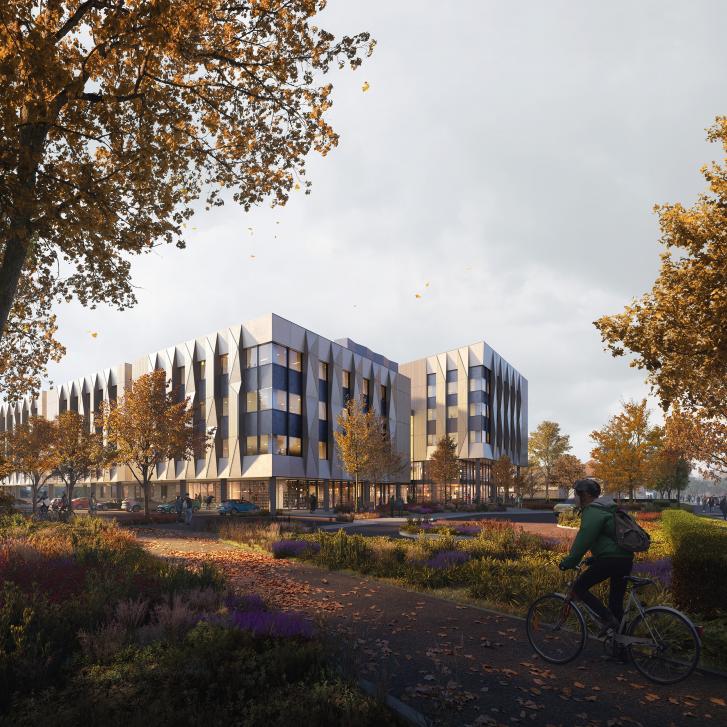
Mission Street has submitted its planning application for the redevelopment of the DFS and Carpetright site on Botley Road in Oxford.
The specialist developer of R&D facilities plans to invest more than £100million in a new facility, continuing the transformation of the area into a sustainable, urban innovation district.
Following over a year of pre-application engagement with Oxford City Council, the proposals went out to public consultation in the summer. The application is for 16,992 sq metres of high-quality workspace which will provide ‘science in the city’ and meet the needs of Oxford’s growing innovation, tech and life science occupiers.
Demand for this type of workspace currently far outstrips supply with in-town, connected locations much sought after by occupiers in the sector. The site is close to Oxford city centre and within easy reach of Oxford railway station on foot or by bike.
Colin Brown, Development Director at Mission Street, said: “We took our initial ideas to public consultation in July and we’ve been having lots of conversations with many people over the last few months. We want to provide a building of the highest quality that also delivers on the widest range of priorities for the local community and the city of Oxford – and we’re really excited about what we’re now submitting. The scheme is better because it responds to what people have said is important to them. We’re tremendously grateful for the feedback we’ve had.”
In terms of the building’s design, Mission Street and architects NBBJ (who are also designing the Life & Mind Building in Oxford), have made key changes including:
- Finishes and materials for the building facades and elevations to make them more attractive and in-keeping with the site’s setting
- Lowering the height of the building – in particular the eastern section where a storey has been removed and the relationship to neighbouring Earl Street much improved
- Articulating the roof and the roofline so that it makes a better contribution to the skyline – long views have been rigorously tested by the design team and in line with the Council’s recommended approach which ensures the effective mitigation of any potential heritage impacts
- Reorganising the café and publicly accessible areas to make them more welcoming, more prominent and to give them better views into and out of the building
- Increased tree planting and additional lighting and landscaping to improve the frontage to Botley Road as well as enhance security and the site’s boundary with Earl Street
The designs have also benefited from technical appraisal from Oxford City Council planning officers through a series of pre-application meetings as well as the ‘Oxford Design Review Panel’ process.
Beyond the physical designs, Mission Street has incorporated feedback from its conversations with stakeholders, local councillors, Oxford City Council economic officers and others to bring in other changes which include:
- A commitment to making this Oxford’s first Living Wage building – with all future occupiers and service providers mandated to pay the Oxford Living Wage to all staff
- A community employment plan and an education plan to formalise commitments on engagement and social benefits – working with local schools and training providers to inspire and to facilitate young people to work in STEM subjects
- Further reducing car parking spaces (reduced from 159 to 74) and instead increasing cycle facilities and active travel features
- Car club spaces and EV charging points which can be made available to local residents at evenings and weekends
Mission Street has applied to Oxford City Council for detailed planning permission for the scheme. The Council has now validated the application and has opened its formal public consultation on the proposals, which runs until 5 February.
The application can be viewed and commented on at the link below with reference number: 22/03076/FUL
Mission Street will continue to provide updates via its project website and is intending to continue its dialogue with local councillors and the community in order to explain the scheme changes and ensure everyone interested in the proposals can understand what’s changed and what has been applied for.
DFS and Carpetright have leases which run until 2024. The timetable for next steps will be informed by the Council’s assessment of the planning application and its decision on the application.
The latest iteration of the design consists of two ‘blocks’ of laboratory and office accommodation either side of a large, glazed atrium. The eastern block is now four storeys in height and the western block five storeys. The building services and plant (at roof level) have also been reorganised to be more efficiently integrated into the building and set back from the eastern elevation.
When complete (subject to planning permission) the building would offer office and lab workspace for a range of occupiers creating a total of between 600-700 jobs.
The Botley Road location – close to the city centre and within easy reach of transport connections as well as all the amenities of the city centre – is both highly sustainable and highly desirable for occupiers. Being ‘in the city’ is increasingly important to science, tech and innovation businesses who want to give their employees access to vibrant, urban locations.
Recognising the importance of sustainability, the new building is designed to meet the highest standards of energy efficiency (achieving a BREEAM ‘Excellent’ sustainability rating as a minimum) and includes solar panels, air source heat pumps, EV charge points, and has low embodied carbon design features including a timber atrium structure and recycled cement replacement in the concrete frame. The location itself is also inherently sustainable – close to the city centre and the railway station – and, with more than 200 cycle parking spaces together with excellent showers and changing facilities – the building will encourage ‘active travel’ and people who want to bike, walk or run to work.
A Statement of Community Engagement (SCE) has been submitted with the application and catalogues the full extent of Mission Street’s conversations and consultation with the community and stakeholders, together with its responses and explanation of the changes and improvements made.




